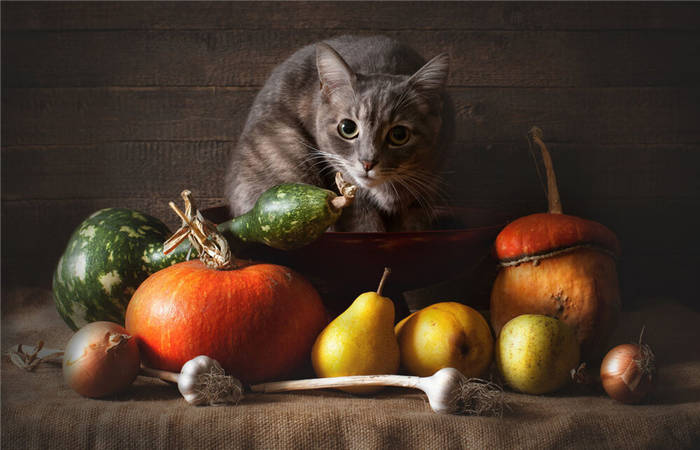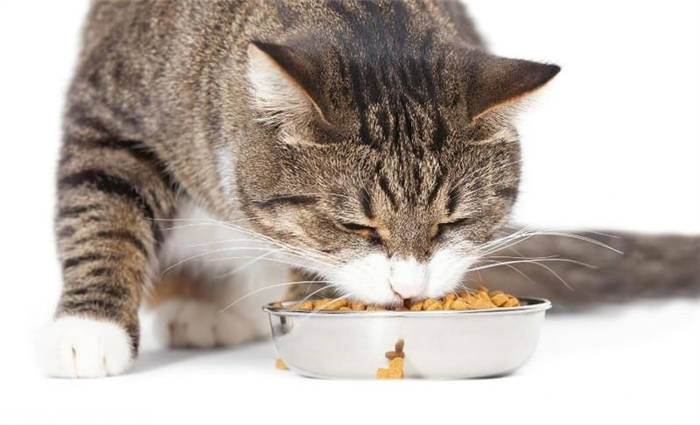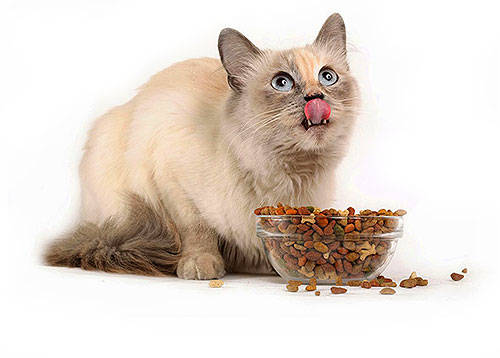The fiber content in a cat's diet should be 3% of dry matter. Old, obese cats need more dietary fiber.

Fiber in a cat's diet
Before we find out if a cat needs fiber, let's define the concept itself. Fibers are fibers composed of components that represent a type of carbohydrate. Some of the most common types of fiber are cellulose, hemicellulose, pectin, lignin and gum.
Fiber is classified by structure, degree of fermentation, ease of digestion, water solubility and other criteria. The properties of different kinds of fiber determine their functions in the body.
Why is fiber so important?
Fiber stimulates the intestinal function and plays an important role in the formation of feces. Lack of fiber leads to intestinal distress. It stimulates the excretion of bile, prevents the development of stagnation, promotes the elimination of cholesterol from the body.
When talking about fiber in cat food, we usually mean the amount of fiber, but actually the degree of fermentation is more important. The rate at which fiber is broken down affects the formation of feces in the intestine. Slowly fermenting fiber retains its structure longer and retains more fluid. Fast-fermenting fiber is the opposite. In fact, giving a cat food with a high amount of fast-fermenting fiber can cause a laxative effect and result in diarrhea.
Natural cat food
Hello, Cat, 9 months old, weight 3 kg, spayed January 31, 17, on a natural diet. Questions:
1) The daily rate should be up to how much of the weight of the animal? I was told that up to 10%, then in our case up to 300 grams. Is this correct? (Although so much will not eat)
2) Of these, how much % protein, carbohydrates, fiber, and pussy milk should be given?
3) Of those listed below, what can be given TODAY and what less often and how many times a week. Here is a list of foods she eats:
Protein – beef, chicken, turkey, rabbit, by-products (chicken heart, stomach, less often liver)
Carbohydrates – buckwheat, oatmeal, rice (probably not very often, since it leads to constipation), millet and semolina (I do not know if it is allowed or not.)
BLOOD – carrots, pumpkin, beets, zucchini, cabbage (I do not know what kind can be white or cauliflower or broccoli. )-I give them in boiled form with meat
BLEND – cottage cheese (either skimmed or up to 5-9%), more often kefir, bio-starch or biokefir 2.5%, more rarely ryazhenka as it is fat
Which of these products can I eat everyday and which can I restrict less often?
4) Do Pumpkin, Carrot, Zucchini, and Milk make me constipated since I used to drink milk and often have hard stools
5) What foods should I include to soften stools? (I add rye bran to kefir about 0.5 hl 2-3 times a week). WHAT'S NEXT.
6) I give yolk and fish 1-2 times a week
7) Low fat broth (sometimes adding 0.5 ql to broth to encourage eating) If I give kefir, is it necessary to keep it a day or two open in the fridge, as it contains alcohol.
If I give kefir, is it necessary to keep it a day or two open in the fridge, as it contains alcohol.
9) Also, is it true that the porridge can not at all, as not digested and can ferment in the intestines OR vice versa, normalize the gastrointestinal tract.
10) Where on the site to read info. about natural food?
I WOULD BE VERY GRATEFUL AND GRATEFUL FOR A DETAILED ANSWER FROM AN EXPERT. Answer can be emailed to [email protected].
She used to feed Royal Kanin, Bosch Sanabel, but refused to drink enough, as can be seen by the color (concentrated) and the amount (20 ml per day) of urine, so switched to natural food and trying to pick up what to what and how much.
Stool every other day, but dense, maybe because of the milk. or pumpkin. or wrong ratio. Although she herself is active. THANK YOU FOR ANSWERING ALL MY QUESTIONS
A cat's natural diet
Cats are obligate carnivores or "true" carnivores. Their natural diet consists almost entirely of meat. A study published in 2011 evaluated the nutrient profile of the diet of free-ranging feral cats. The study found that about 63% of the diet was protein, 23% was fat, but 3% was carbohydrates. These carbohydrates in the diet appear to have two sources.
First, in the contents of the victim's stomach, which they eat. Research has shown that most feral cats fed on small mammals and birds. These predatory animals tend to eat large amounts of vegetation, so when the cat ate an animal, it also swallowed whatever the prey ate. However, the study also showed that the bones, fur and feathers of these animals are largely indigestible and can have the same effect on a cat's digestion as fiber does on human digestion.
Second, many cats often ate several strands of grass. There are several theories as to why they do this. It may be to soothe an upset stomach, it may be because of the folic acid in the grass, or it may act as fiber to aid digestion and act as a natural laxative.
Two types of house cats
We can divide domestic cats into two main groups – cats that have access to the outdoors and cats that live exclusively indoors. You may not realize it, but the nutritional needs of these two groups are slightly different.
- Cats that have access to the outdoors. Cats that live outdoors or have some access to the outdoors generally do not need cat fiber supplementation. They will probably forage and hunt, and that is where they will get any dietary fiber. They will still need quality cat food.
- Domestic cat.. The needs of a domestic cat are a little more complicated. Domestic cats tend to be less active than their domestic counterparts. This also means they are a little more likely to be overweight. High-fiber cat food is one way to control a cat's weight. The fiber in the food can make her feel a little more full after eating, which reduces the amount of food she actually eats. If your cat is overweight, you should gradually switch to a food that is high in protein, fat and fiber, but low in digestible carbs.
High fiber cat food can also help your cat maintain a healthy weight. This is an especially good idea if he is prone to weight gain.

The high fiber content also helps get rid of hairballs. Household cats are prone to hairballs. They spend about four hours a day grooming and can ingest quite a lot of hair. The hair is not digested and accumulates in the stomach. The same abdominal muscle contractions that help digest food also pick up all those hairs and form a hairball. It's usually not serious, but it does cause some discomfort. If the cat has dietary fiber, it can help the hairball move through the digestive system, reducing the discomfort it feels.
Do raptors need fiber?
The nature of a cat's diet is diametrically different from that of humans. Ten to 15 thousand years ago the dog was domesticated, 10 thousand years ago the first cat appeared in the dwellings of primitive man. Domestication leads to changes in appearance, inevitable shifts in nutrition, and the appearance of traits useful in human economic activities.
In the process of domestication the cat underwent a number of changes in its internal structure and external traits. The brain shrank, the legs shortened, and the intestines became longer to better absorb the not always full-fledged food offered her from the table by her owners.
However, unlike other pets, the cat remains a true carnivore (the basis of its diet was and still is meat). The ratio of digestive tract length to body weight in cats is 2.8-3.5%, in large dogs 2.7%, in dwarf dog breeds 7% and in humans 11%. A cat's digestion begins in the stomach (the cat swallows food with little or no chewing, cutting it open with its sharp teeth). A cat tastes food 18 times worse than a human, and the small carnivore's sense of smell is 3-4 times sharper. The cat's stomach volume is small and amounts to
0.3 liters, the gastric juice reaction is very acidic (both cat and dog have pH =1-2) to effectively digest meat, including spoiled meat. Food only stays in the cat's body for 12-24 hours; this is because cats' intestines are short.
There's life everywhere.
A cat's large intestine contains about 10,000 bacteria/g, forming the normal intestinal flora (in humans, this number is 10,000 times higher). Intestinal bacteria synthesize several vitamins (including K, Bc etc.), release trace elements for better penetration into the blood, produce fatty acids, which they feed themselves and give to the cat.
Microbial imbalances resulting from disease or poor nutrition cause domesticated predators to sometimes eat bits of their congeners' feces. The beneficial microflora that enters the body when eating the entrails of the victims can partially enter the intestines alive, despite the detrimental effects of gastric hydrochloric acid. The composition of the microflora is influenced by the nature of the diet: the best conditions are balance and consistency (abrupt change of food is unacceptable).
Natural food: pros and cons
Every cat needs a balanced diet consisting of foods rich in proteins, carbohydrates, fats, vitamins and minerals. The pet can get them from natural products prepared by the owner himself.
The benefits of feeding a natural cat food is that you will know what foods are in the pet's diet. And you certainly will not allow any "chemicals" there. In addition, industrial food looks unnatural, unaccustomed to humans. Therefore, owners often have doubts about the benefits and safety of this type of feeding.
The disadvantage of using natural products for cat nutrition is that cooked food spoils quickly and requires knowledge, skill and time to prepare.
If you have decided to become your cat's nutritionist and learn the basics of cooking for animals, read our article below.
Covenantal FFAs: natural cat food nutrition
There are no uniform rules in compiling a cat's diet. It all depends on the individual characteristics of the animal. Some cats like variety in food, others prefer one or two types of food. If the pet does not like the food, he will starve until the owner will not reckon with his preferences.
When putting together a natural diet, some owners include only meat foods. Remember that carnivores need nutrients, vitamins, micro and macronutrients, which are contained in plant foods. Lack of these substances affects the appearance of the pet: cat hair begins to fall out, pile up into tangles and dandruff appears.
To make sure that the cat's diet is balanced, it should include high-quality foods containing proteins, fats, carbohydrates, vitamins and minerals. We will talk about the main sources of nutrients in the cat's diet separately.
Fibers for cats in what foods

Л Any purebred animals and pets that can't boast of a noble pedigree need a nutritious diet. That said, a proper menu for a cat is quite different from the list of essential foods for humans. There is no place in it for cereals and flour products, as well as porridges. These products can disrupt the normal intestinal microflora of carnivorous creatures. In addition, alcohol and wine-based sauces, cocoa and chocolate, tea and coffee, as well as broccoli, onions and garlic have no place in a cat's diet. Animals also do not digest legumes such as beans, soybeans or peas. Their consumption leads to bloating of the stomach. It is also not recommended to give pets of the cat family solanaceae family fruits such as tomatoes and potatoes, which cause severe gastrointestinal cramps.
A healthy diet for pets should be monotonous and specific – not requiring much heat treatment. It consists of medium-fat dairy products, raw meat and by-products – kidney, rumen, heart. Of vegetable food it is recommended that cats be given vegetables and some kinds of unsweetened fruit.
Note. Nutrition to a large extent forms the immune system of the animal and an incorrect diet can have a significant impact on the health of the cat. The intestines play a key role in the defense and life support system of the animal's body. The presence of dysbacteriosis due to an incorrect diet can lead to the development of many pathological disorders – allergies, obesity, chronic inflammatory processes, disorders in the function of internal organs.
If you're not sure you can provide your pet with a proper diet, it's better to just buy pet food in Pavlovskaya Sloboda. Prepared set of ingredients, selected by experienced specialists, as a rule, already contains the necessary substances for the normal life of the animal. However, if you give your cat dry food containing 40-55% cereals, yams and corn, as well as porridges, it will not be possible to maintain the intestinal microflora in a healthy state.
What is fiber
All insoluble carbohydrates are grouped under the general name "dietary fiber" or "crude fiber" and include cellulose, hemicellulose, pectin, and lignin (which is a structural component of the plant wall).
1. Soluble fiber dissolves in water to form a gel-like substance. Some examples of foods rich in soluble fiber are: oats, barley, peas, psyllium, apples, and carrots. Soluble fiber is often fermentable, which means that the gut microbiota can use it as an energy source.
2. Insoluble fiber, as the name implies, is insoluble and the main sources of this type of fiber are: whole wheat flour, wheat bran, potatoes and nuts.
What is the purpose of fiber
Fiber performs many essential functions. Here are some of them:
1. Helps the pet effectively shed extra pounds. Fiber is "bulk," so it can help pets feel fuller for longer, making them less likely to beg for more food. Weight loss diets that include higher levels of fiber, such as food Hill's Prescription Diet Metabolic , allow you to give your baby the same amount of food compared to a regular diet, but it will have fewer calories, which promotes weight loss.
2. Fiber for diarrhea and constipation. Fiber can normalize intestinal water content by absorbing water from the lumen contents if the animal has diarrhea and by adding moisture to fecal matter in animals with constipation. It is recommended to add fermentable fiber (psyllium, pectins or FOS) to the diet of dogs and cats suffering from constipation, since the gas produced by fermentation of these fibers can help break down the fecal matter. Psyllium is also able to absorb water, which increases the volume of feces. Thus, softer stools are formed, which pass more easily.
3. It has been reported that patients with irritable bowel syndrome (IBS) improve their clinical condition when their dietary fiber content is increased. Increased intake of dietary fiber can alter fecal water content, colonic peristalsis, and the rate of intestinal transit. Plantain husk has been successfully used in the treatment of IBS.
4. Diabetic pets may also benefit from a high-fiber diet. This is because some fiber slows the absorption of nutrients, allowing sugars from starches to be absorbed more steadily and therefore stabilize blood sugar levels.
5. Help improve the microbiome. Fiber serves as food for healthy microbiota, which of course has a positive effect not only on the health of the gastrointestinal tract, but also on the whole body. Here are just a few of the benefits of a healthy microbiome:






